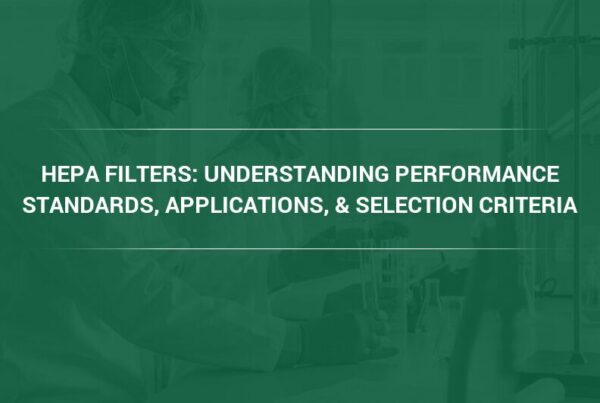Clean Air Solutions – For years, the Environmental Protection Agency (EPA) and Centers for Disease Control and Prevention (CDC) have warned the public about the dangers of secondhand smoke (SHS), also known as environmental tobacco smoke (ETS). In fact, the EPA estimates that 3,000 lung cancer deaths per year are caused by secondhand smoke—a finding used by proponents of smoking bans. Arguments against these policies, however, point to the use of commercial air filtration systems to eliminate the health hazards from exposure to secondhand smoke. (1)
“The burning of tobacco causes the emission of over 4,500 compounds, including 50 suspected carcinogens,” said Charlie Seyffer, Manager of Marketing & Technical Materials at Camfil USA. “Where tobacco smoking is allowed in public indoor areas, filtration devices are often employed to remove contaminants and ensure the comfort and safety of non-smokers in the same room or building.”
How do Commercial Air Filtration Systems Work?
Commercial air filtration systems work by drawing in air, passing it through a series of filters that trap the chemical and particle contaminants, and then releasing the filtered air back into the room. Granted, this is a simplification of what is often a complex, multi-stage process, but it more or less describes the principles behind air filtration technology.
While most homes and commercial establishments use air filtration systems to deal with allergens like pollen and mold, certain industrial air filter manufacturers have also created systems designed to remove hazardous tobacco smoke.
Two Ways Industrial Air Filter Manufacturers Remove SHS
Of course, the most effective way to eliminate the health risks of secondhand smoke is to completely prohibit indoor smoking. While some establishments, particularly casinos, may allow smoking to help keep patrons comfortable, they also have to ensure that indoor air quality (IAQ) remains tolerable for non-smokers. The same can be said for the IAQ in smoking lounges in airports and restaurants. As a result, industrial air filter manufacturers have introduced two popular solutions for removing tobacco smoke—HEPA filters and molecular filtration through activated carbon.
SHS Removal by Industrial HEPA Filters
Industrial HEPA (high-efficiency particulate air) filters are specifically designed and certified to remove particulate matter down to 0.3 microns in size at an efficiency rate of at least 99.97 percent. Interestingly enough, these fiber filters were first designed as a way to shield scientists from nuclear radiation.
On the other hand, an ultra-low penetration air filter (ULPA) is a variant of a HEPA filter, certified to remove 99.999% of dust, pollen, mold, bacteria, and other airborne particles down to 0.1 microns in size.
The toxic, odor-causing particles in cigarette smoke range in size from .02 to 5 microns, which makes them within the right size to be captured by a HEPA filter. Since smoke rapidly thins and disperses after it is burned or exhaled, causing the contaminant particles to shrink further and further in size, a HEPA filter is most effective when it can capture secondhand smoke before it has spread too far.
Removing Smoke with Molecular Filtration Systems
Molecular filtration systems use activated carbon, a microporous adsorbent made from a carbonaceous material that features a network of extremely small connected pores and fissures down to a size of 0.1 micron—visible only with the use of a microscope. This porous structure is made by heating carbon to extremely high temperatures, thereby “activating” it. In fact, a tiny pellet of activated carbon can have the internal surface area of a football field when scaled to size.
As the contaminant particles enter the activated carbon filter, their molecules enter the large pores on the surface and make their way into the smallest pores until they are eventually trapped—a process called diffusion. Activated carbon filters are especially effective at absorbing volatile organic compounds (VOCs), tobacco smoke being one of them.
In fact, molecular filtration systems are commonly used in:
- Airports – to remove kerosene fumes
- Museums – to remove sulfur, nitrogen oxides and artifact-damaging ozone
- Nuclear facilities – to remove iodine, krypton and xenon
- Pesticide factories – to remove pesticide fumes
- Food and beverage facilities – to remove cooking odors
A Final Note on Industrial Air Filtration and Ventilation Systems for Secondhand Smoke
Ultimately, the two best ways to deal with indoor air quality problems caused by secondhand tobacco smoke is by removing the source of the pollution and opening the windows. But for situations where these options are impractical, installing a robust industrial air filtration and ventilation system is the best way to maintain outstanding indoor air quality by removing residual gases, odors, and particulate matter.
It’s also important to realize that not all commercial air filtration systems are the same. As with any product, some systems are better than others. A high-quality HEPA filter, for example, will remove 99 percent of contaminants as advertised, while a more affordable filter from a lesser-known brand likely won’t be able to capture half that amount. A HEPA filter should be built to industry standards and individually tested to confirm performance.
To learn more about the benefits of commercial air filters for indoor air quality, visit Camfil USA’s complete air filter catalog. Or find your local Camfil USA branch here: https://cleanair.camfil.us/locations/
Other Resources for You:
- Learn Why You Need to Be Using HEPA Filters Previous blog post
- Read our blog post: How Harmful Is the Air Quality on Planes
Lynne Laake
Camfil USA Air Filters
T: 888.599.6620,
E: Lynne.Laake@camfil.com
Y: Watch Camfil Videos on YouTube
F: Friend Camfil USA on Facebook



